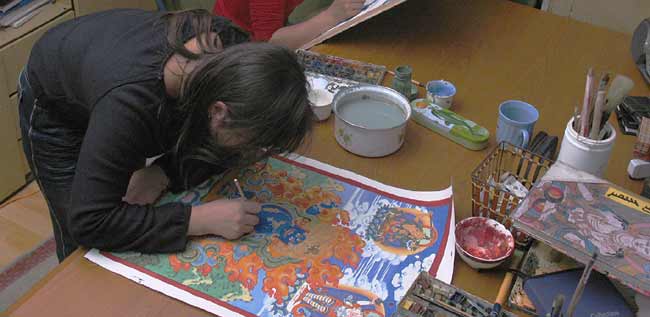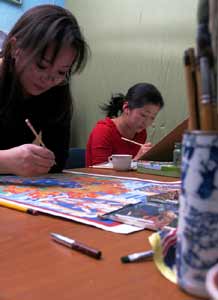|
- Catalog (in stock)
- Back-Catalog
- Mail Order
- Online Order
- Sounds
- Instruments
- Projects
- History Face
- ten years 87-97
- Review Face
- our friends
- Albis Face
- Albis - Photos
- Albis Work
- Links
- Home
- Contact
- Profil YouTube
- Overton Network
P & C December 1998
- Face Music / Albi
- last update 03-2016
|
|
|
The Mongolian style of Tibetan painting maintained the iconography but adapted the details of the background. In Tibetan thangkas (scroll paintings framed in brocade), the backgrounds typically have stylized snow-capped mountains and lakes. In Mongolia, the rolling grasslands and hills of Mongolia are more frequent. The small human figures in the background tend to look more like Mongolians than like Tibetans, and eventually the facial features of the main deities also acquired Mongolian traits. Thus, the faces tend to be larger and rounder than Tibetan ones. The Mongolians also tend to use more shading than the Tibetans to depict body musculature, although this is occasionally found in Tibetan thangkas as well.
The Buryats follow the Mongolian style, with some minor variations in details. The Chinese style of Tibetan thangkas had typically bright, garish Chinese colors, in contrast to the more subdued colors of the Tibetans. They had a great amount of gold leaf work, more than the already considerable amount found on Tibetan thangkas.
|
| - Mongolian thangkas are colored painted on black, red, or gold background. |
| - Gau; thangkas in brass, silver and copper. |
- Parma; painted prints; pressed from wood block onto cotton, then painted and framed as thangkas
|
The Qianlong emperor of China was known to have remounted Tibetan thangkas in the Chinese style.
|
|
Der mongolische Stil der tibetischen Malerei behielt die Ikonographie bei, adaptierte aber die Details auf dem Hintergrund. In tibetischen Thangkas (Rollengemälde, die in Brokat gerahmt sind) weisen die Hintergründe gewöhnlich stilisierte schneebedeckte Berge und Seen auf. In der Mongolei sind Motive von sich erstreckenden Graslandschaften und Hügeln häufiger. Die kleinen menschlichen Figuren im Hintergrund sehen eher wie Mongolen denn wie Tibeter aus, und schliesslich nahmen auch die Gesichtszüge der Hauptgottheiten mongolische Spuren an. Auf diese Weise wurden die Gesichter grösser und runder als tibetische Gesichter. Die Mongolen neigen auch dazu, mehr Nuancierungen als die Tibeter zu verwenden, um die Körpermuskulatur darzustellen, obwohl sich diese Charakteristik auch in tibetischen Thangkas finden lässt.
Die Burjaten folgen dem mongolischen Stil, zeigen aber in den Details geringe Abweichungen. Der chinesische Stil der tibetischen Thangkas zeigte sich gewöhnlich durch helle und grelle chinesische Farben, was im Gegensatz zu der eher gedämpfteren Farbpalette der Tibeter stand. Sie wiesen eine grosse Menge an Goldblattwerken auf, noch mehr als die bereits sehr vielen Arbeiten, die sich auf tibetischen Thangkas fanden.
|
| - Mongolische Thangkas sind farbiger auf schwarzem, rotem oder goldenem Hintergrund gemalt. |
| - Gau; Thangkas in Messing, Silber und Kupfer. |
- Parma; gemalte Drucke; von einem Holzblock auf Baumwolle gepresst, danach bemalt und als Thangkas gerahmt.
|
Es ist bekannt, dass der Qianlong-Kaiser von China tibetische Thangkas im chinesischen Stil wieder aufstellen liess.
|
|

Studio - Bi-Bid - more information about thangkas see: History of Mongolian art of Buddhists
 Nurmaa Tuvdendorj Nurmaa Tuvdendorj |
 |
Sakhuis - Fine Art of Mongolia, which includes the Buddhist bronze sculptures and painting thangkas. The deities depicted in the sakhuis have a vigor and vitality typical of the people of the Steppes. They are thought of as sacred objects and used as amulets. The deities of the pantheon are divided so as to represent the dual nature of all things in the Universe. There are the strong and vengeful manifestations of deities who maintain order through authority and fear, such as Mahäkäla, as well as the nurturing deities such as Tara and Bodhisattva Avalokitesvara.
Sakhuis (text in German) - gehört zu den mongolischen Schönen Künsten, die buddhistische Bronzeskulpturen und Thangkas umfasst. Die in den Sakhuis dargestellten Götter besitzen eine Lebendigkeit und Kraft, die für die Völker der Steppe sehr typisch sind. Sie werden als heilige Gegenstände angesehen und als Amulette verwendet. Die Götter des Pantheons sind geteilt, um so die duale Natur aller Dinge im Universum zu veranschaulichen. Es gibt starke und rachsüchtige Darstellungen von Göttern, die durch Autorität und Angst die Ordnung der Dinge herstellen, so etwa Mahäkäla; es gibt aber auch sich sorgende Götter wie Tara und Bodhisattva Avalokitesvara.
Below you can see great examples - click on an icon - Enjoy!
|

